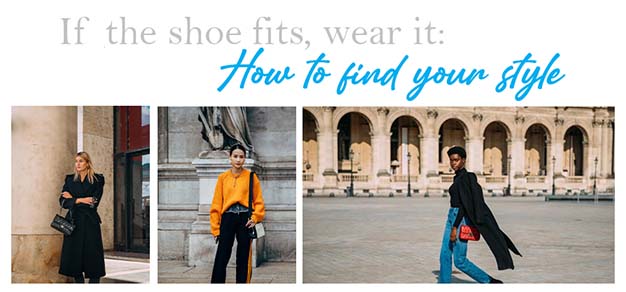If the shoe fits, wear it: How to find your style

No, I won’t force you to pull out your measuring tape and analyze every limb of your body. Although, tailoring your clothes produces an exceptional fit, there are many simpler techniques to accomplish your best look. The first step is to understand that there are four elements and five principles of fashion design. I know, it sounds daunting, but I am here to guide you!
To recognize your individual style, learning about the basics may help direct you towards your personalized look.
Let’s begin with assessing the four elements of fashion design which include texture, line, colour, shape and form.
The Elements
1. Texture
Tactile and visual are the two categories of textures. Tactile texture is the physical feeling of the garment (i.e., fur, silky, rough, and smooth) and visual texture is based on the appearance of the fabric (i.e., shiny, glossy, and matte).
The purpose of texture is to either enlarge or reduce the structure of the body. It creates an illusion of (more or less) weight and which allows an individual to appear oversized or slender.
2. Line
Lines can be vertical, diagonal, horizontal, and curvature.
They are utilized on garments to lengthen or narrow the figure. They may also produce shapes and construct a partition on the fabric.
We tend to use lines when we desire to appear taller, slimmer, or wider.
3. Colour
Colour creates an emotional connection within yourself and amongst others. Colours in fashion are developed from the colour wheel, colour theory and colour psychology.
Colour psychology uses history, studies, and statistics to assign meanings.
For example, the psychology of red states that it elicits energy, affection, and authority. Many findings reveal that red is the traditional pigment of love, which makes people who wear it appear more attractive.
The colour wheel uses three primary colours that form a triadic colour scheme. Mastering your understanding of analogous colours and complementary colours on fabric will help enhance your apparel.
Colour theory uses colour harmony, colour temperature, and colour context to help you decide the suitable tones of hues which best fit you. An example of this includes discovering your undertones and determining whether cool or warm tones best suit you.
4. Shape and form
Shapes and forms use colour, texture, and lines to produce two-dimensional and three-dimensional features, respectively.
This element is widely used in avantgarde and haute couture fashion.
Next, all these elements of fashion assemble to fulfill the principles of fashion. The five main principles of fashion design are balance, proportion, emphasis, rhythm, and harmony.
The Principles
1. Balance
Balance is a visual perception that creates symmetry or asymmetry in garments. For example, we can create equilibrium on our outfits using equal weight from top to bottom or from side to side.
2. Proportion
Proportion helps to blend and merge an outfit. A relationship between the various elements form to complement your body type. Understanding your body type is a key component of this notion.
It is recommended that a petite individual shouldn’t dress in voluminous outfits.
3. Emphasis
Emphasis is also known as the “centre of attraction” component. This technique arranges a focal point using the different elements and additional features to draw attention.
4. Rhythm
Rhythm uses repetition to construct a coordinated look. The fundamental objective in rhythm is to avoid variety between the elements, but to engage in variation within an element.
Pinstripe shirts, row of buttons, and pleated skirts demonstrate this idea.
5. Harmony
Harmony unifies and concludes an outfit. This final rule joins the other principles to form a perfect outfit.
For instance, a “fun” dress may be asymmetrical and voluminous, with repetitive hues of vibrant colours. This dress wouldn’t be viewed as formal but would be ideal for a party.
This was a quick guide to the basics in fashion design. Knowledge in the fundamentals will help you develop your style. Then, creating mood-boards and following your favourite well-dressed celebrities will help cultivate your desired look.
















